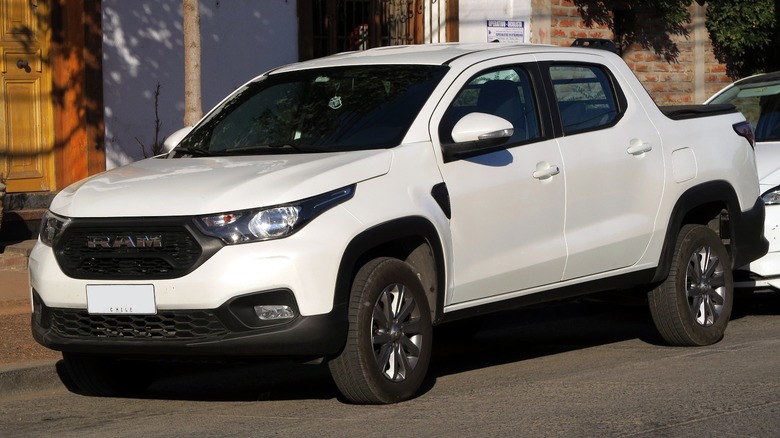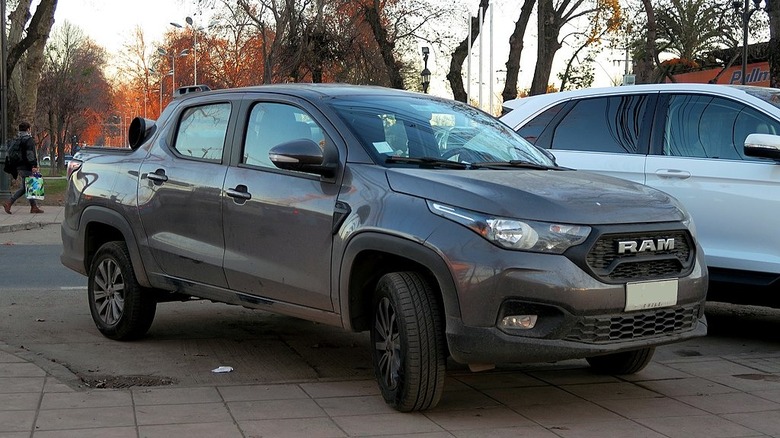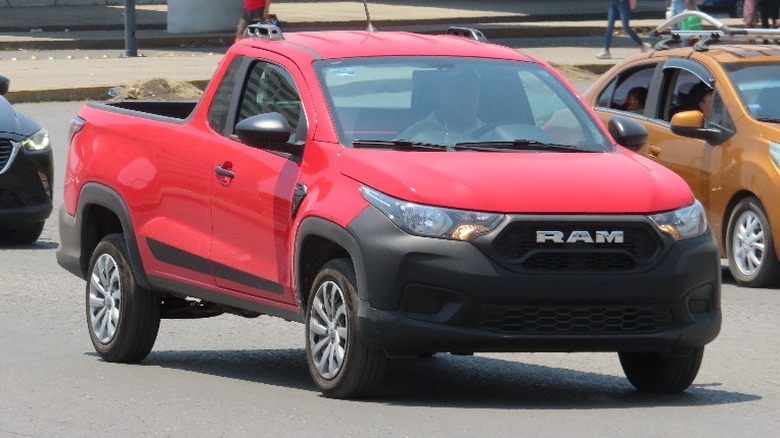What Is The RAM 700, And Can You Get One In The USA?
America's love affair with pickup trucks is a decades-long relationship that only appears to be growing stronger as traditional passenger cars disappear from the lineups of many automotive manufacturers. The Ford F-Series has been the best-selling vehicle in the United States for a remarkable 42 years, with over 700,000 units sold in 2023. As sales of trucks have grown here in the states, so has their overall size, cabin space, and price. The factors, along with a dearth of affordable new cars, left a gap in the market as sales of midsize and compact cars continued their steady decline.
Seizing on the potential sales opportunity, in 2021, Hyundai and Ford introduced smaller unibody pickups in the Santa Cruz and Maverick that offered features that full-size and mid-size pickups are lacking — good fuel economy, great packaging, and functional utility without a turning circle rivaling that of an aircraft carrier. While sales results of the Santa Cruz have been mixed, Ford has had a bona-fide hit on its hands with the Maverick, with sales increasing every year since introduction and demand outstripping availability.
With such strong demand for the Ford Maverick, is there room for another compact pickup truck to compete in the segment? Those in the know might see an opportunity for Stellantis to do just that with the Ram 700, a compact unibody truck sold exclusively in Mexico that has similar dimensions and capabilities to the aforementioned diminutive haulers from Hyundai and Ford.
[Image by RL GNZLZ via Wikimedia Commons | Cropped and scaled | CC BY-SA 2.0]
The Ram 700 is a rebadge of the Fiat Strada
While Fiat is better known here in the United States for the compact vehicles with Italian flair like the 500e and 124 Spider, the marque is also a purveyor of utility vehicles like the Ducato, a high-roof utility van that serves as the basis of the Ram ProMaster here in the states, and the Strada — a compact pickup that is a strong seller in Latin America, including Brazil where it is manufactured. The Strada and the Ram 700 are virtually identical, with only front-end body work differentiating their styling.
The Ram 700, mirroring its larger American cousins, features three trim levels: the base SLT, which offers single and double cab configurations, and the more costly and better-equipped Laramie and Bighorn options, which are offered only as four-doors. The trucklet comes standard with a 1.3-liter four cylinder making 100 horsepower and 99 lb-feet of torque and a five-speed manual transmission. While this leaves it considerably down on power compared to its potential American competitors, the Ram 700 is capable of hauling up to 1,587 lbs in its entry-level two-door trim – nearly identical to the 1,500-lb capability of the two-wheel drive Maverick and 1,521 load capacity of the two-wheel drive Santa Cruz. On paper, the Ram 700 seems like a solid candidate for Stellantis to introduce to the Ram lineup in the U.S. Unfortunately for the 700, bringing it to the states isn't so easy.
[Image by RL GNZLZ via Wikimedia Commons | Cropped and scaled | CC BY-SA 2.0]
Preparing the Ram 700 for the American market would be full of roadblocks
The formula for bringing the Ram 700 to the U.S. market seems pretty straightforward: Add a more powerful U.S. emissions-certified Fiat engine to it and have it crash-tested. That's an oversimplification, but there are several fundamental issues that would most likely prevent Ram from bringing the 700 to the states.
The first issue is that when the Ram 700 and Fiat Strada in both single and double cab forms were crash-tested by the New Car Assessment Programme (NCAP) for Latin America and the Caribbean, they received one star out of five. In addition to this poor showing, the pickup does not offer safety options that are federally mandated in the United States like blind-spot detection and lane-support systems.
Secondly, there is the not-insignificant issue of the Chicken Tax – a protectionist trade tactic implemented in the 1960s that adds a 25% tariff to any light truck sold in America that is not domestically manufactured. Avoiding this tariff would most likely mean manufacturing the Ram 700 in the U.S., which would add overhead to the 700. That, along with the additional costs of the required safety systems previously discussed, could leave Stellantis at a deal-breaking disadvantage to its competitors when pricing the compact truck.
[Image by Jason Lawrence via Wikimedia Commons | Cropped and scaled | CC BY-SA 2.0]


